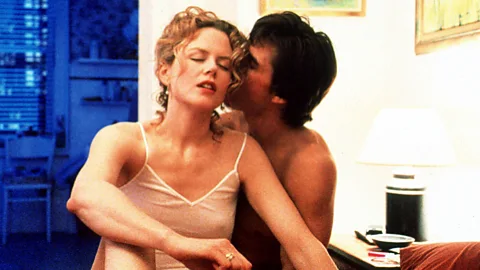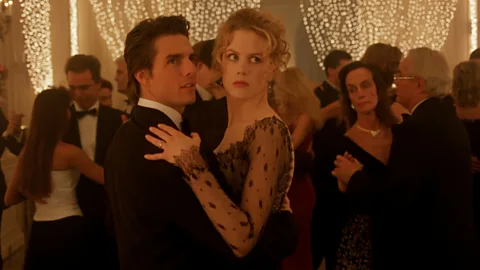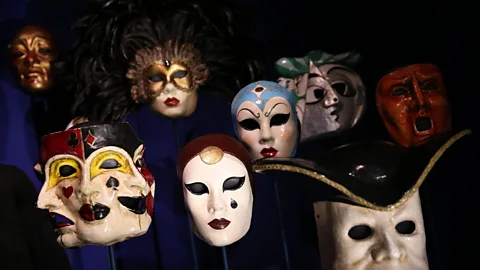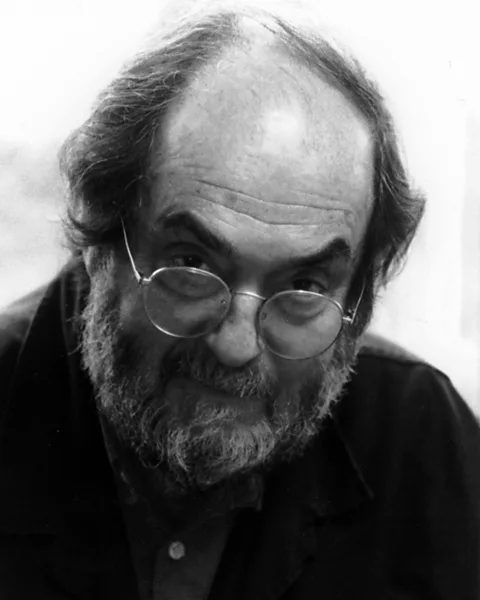The remarkable afterlife of a famous 1990s misfire

10 hours ago
By Thomas Hobbs,
 Getty Images
Getty ImagesStarring Tom Cruise and Nicole Kidman, Stanley Kubrick’s final film was poorly received on its release in the summer of 1999. But 25 years on, it’s been reappraised as a masterpiece and endlessly theorised over.
“Those were not just ordinary people!” warns upper-class financier Victor Ziegler (a slimy Sydney Pollack) to a shaky Dr Bill Harford (Tom Cruise). The latter, a doctor to the elite, is still processing a mansion’s masked ball he snuck into the previous night, which descended into a possibly murderous orgy.
Ziegler, a high-profile client of Bill’s, continues in his trademark arrogant yet fatherly tone: “If I told you their names, Bill, you wouldn’t sleep so well”.
Released 25 years ago this week, director Stanley Kubrick’s divisive swansong Eyes Wide Shut, with a story centring on – among other things – the twisted misdeeds of the rich, has arguably never felt more relevant. Resonating strongly with recent real-life examples of elite degeneracy – notorious sex trafficker Jeffrey Epstein was the “living embodiment of” the shadowy Ziegler, according to new biography Kubrick: An Odyssey – it has subsequently sparked fervent online conspiracy theories about the Hollywood sins the auteur was allegedly trying to expose. From YouTube deep dives to Reddit speculation, there has been a lot of discussion about everything from its supposed prescience to its dense, symbol-filled visuals.
 Alamy
Alamy“All of Kubrick’s movies tend to grow with time and Eyes Wide Shut is structured in a way to deliberately intrigue people and ignite discussions,” film-maker Tony Zierra – who has directed an upcoming documentary, SK13: Kubrick’s Nightmare Dream, dissecting the film’s hidden meanings – tells the BBC. “You see the film’s themes reflected in news events. Whether it’s the exposure of corrupt politicians, or sex scandals [in] celebrity culture or the entertainment industry, Eyes Wide Shut gets mentioned. Kubrick made a film that lives and changes with the time. I believe that’s why he was so proud of it and told all his friends it was his best creation.”
Hype v reality
Yet all this feverish intrigue feels a long way from Eyes Wide Shut’s initial lukewarm reaction. It featured “the dullest orgy ever seen” and a “grindingly pedantic, glacial pace” according to an infamous Washington Post review, while many other reviews were similarly scathing, even if commercially it fared somewhat better. (Indeed, the film remains Kubrick’s biggest at the box office, taking just over $160m (£124m) internationally.)
Marketed as a conventional erotic thriller, the film’s original reveal trailer, which had been edited by Kubrick himself and was soundtracked by Chris Isaak’s Baby did a Bad Bad Thing, suggested an intensely sexual film filled with sensuous glances and hot-under-the-collar friction. The two hour and 39-minute film Kubrick ultimately delivered was very different. Tragically, the director died in his sleep of a heart attack on 7 March 1999 shortly after handing in a final cut.
Eyes Wide Shut is, at its heart, about a couple in crisis: the emotionally closed-off Bill is sent into an existential spiral after his wife Alice (an emotional ticking time bomb of a performance by Nicole Kidman) reveals she once fantasised about sleeping with a sailor she had exchanged glances with on holiday. While Alice didn’t act on her impulses, the encounter has become part of her dreams and subconscious, and this is enough to send an enraged Bill off into the night, where he sleepwalks into one disastrous sexual encounter after another, unsure if he wants to seek out comfort or revenge.
At the time Tom Cruise and Nicole Kidman were Hollywood’s biggest “It” couple, their every move documented by pulsing paparazzi cameras. The salacious hype around the film got to the point where tabloids were actively speculating about how much nudity the film would feature, the misleading trailer undoubtedly throwing fuel on an already burning fire and resulting in audiences confused over the Kafka-esque dread the final film instead delivered. “People were used to Tom Cruise having boyish good looks and irresistible charm, but here he was stripped of any sexual prowess. His male gaze is blunted. It was a very brave performance,” explains Nathan Abrams, a film professor at Bangor University and the co-author of Kubrick: An Odyssey. “Kubrick was dissecting his lead man’s celebrity.”
A deep rumination on marriage, the film is, much like the 1926 novella Rhapsody: A Dream Novel by Arthur Schnitzler it is based on, rooted in the idea of love as a salvation amid dark times. The trailer, therefore, “was a complete miscalculation and it caused a lot of confusion,” Abrams added. “Had Kubrick lived [to see the release], he would have corrected course and changed the marketing completely, I’m sure.”
 Alamy
AlamyA famous perfectionist, Kubrick re-created New York City at London’s Pinewood Studios (including a reference to a Jewish bagel shop he once visited as a young man) and made an exhausted Tom Cruise walk through doors hundreds of times until the shot was just right. There are claims he engineered mistrust between the Hollywood couple, too, with Abrams’ biography alleging Cruise was forbidden to be on set when Kidman filmed sex sequences with another male actor (playing the sailor), creating a tension that would inject their performances with lovelorn angst.
During pre-production, Kubrick had sent out photographers to New York’s Greenwich Village, so they could photograph passers-by for months and months, living in all weather conditions, whose outfits he could then replicate in the film’s wardrobe. He even got them to measure the sidewalks, inch-by-inch. Precisely re-capturing the Big Apple’s aesthetic was especially important. Yet Abrams argues Kubrick was also exhausted from this intense and meticulous process. He slept and ate poorly, while he was so weak he needed to be lifted back up by camera operators after bending down. A 400-day shoot, which was then the longest continuous shoot in Hollywood history, resulted in visible bags under Kubrick’s eyes.
“He was very frail,” Abrams says, pouring cold water on one of the internet’s most popular conspiracy theories around the film: that Kubrick didn’t die of a heart attack…but was rather killed off by the elites for revealing too much with Eyes Wide Shut and its orgy sequence. “He smoked sometimes too. Perfecting the art meant more than protecting his health.”
The theories of a super-fan
One particularly vocal fan is Sean McCann, a podcaster who has dedicated hundreds of hours to theorising about the film. The ending of Eyes Wide Shut famously depicts Bill and Alice walking their daughter Helena through a toy shop. In a witty yet fraught exchange, the married couple decide to finally move on from all their petty jealousies and mind games by working things out in the bedroom. Biographer Abrams believes it’s one of the most hopeful endings of any Kubrick film.
McCann, however, insists it in fact features Helena being kidnapped (he claims two bald men in the background usher her away) and that the “Magic Circle” boardgame seen in the toy shop (its cover image replicating the blood red circle floor at the orgy) is a reminder that the cult Bill barely escaped from has ears and eyes everywhere. In McCann’s imagining, they’re finally punishing Bill for revealing their existence to his wife given that, at the sinister orgy, a mysterious figure in a red cloak (played by Kubrick’s long term assistant, Leon Vitali) warns Dr Bill of “dire consequences” for his family should he ever speak out.
He says another earlier sequence, where Bill sneaks into the masked ball with the password “Fidelio”, is filled with Freemason symbolism (including the Eye of Providence, which can clearly be seen as part of an eerie Venetian mask) and allusions to royalty (Bill is advised to wear an ermine cloak, a material associated with kingly robes). These are hints from Kubrick, McCann says, of the types of elites who might attend one of these masked parties and the existence of secret societies. “I do get a buzz out of it!” McCann admits of his devotion to dissecting the film. “It’s because I like to understand the hidden meanings behind things. The process of discovery makes you feel more enlightened. I’d say I was watching this movie twice a week, at least, for around two to three years.”
Rather than seeing it as a film rooted in exposing hidden realities, Abrams says Eyes Wide Shut is about “unreality”, and should be considered as a “dreamscape”. For some street scenes, Kubrick filmed Cruise walking on a treadmill, giving a floaty peculiarity to his movement, and the recurring use of red neon lights imbues the film with a trippy glow caught right between Christmas comfort and living nightmare. The central musical theme, meanwhile, is a chopped and screwed up series of backwards chants by Romanian priests. “The film is set in December, yet you can’t see anyone’s breath in the air,” explains Abrams. “It all adds up to this air of unreality.” Meanwhile the movie opens with Alice literally looking through the looking glass – an ode to the surreal Alice’s Adventures In Wonderland. Abrams agrees with Pollack, who once speculated of the film’s psychedelic powers: “I don’t think there was much in Eyes Wide Shut that was realistic, or that was intended to be realistic.”
 Alamy
AlamyIt’s a great irony, then, that online theorists come away with such definitive ideas about what the hallucinatory Eyes Wide Shut means. However, this also wouldn’t be the first time a Kubrick film has sparked so much rigorous debate over its true meaning. Some believe the dense The Shining is littered with references to the holocaust and genocide of Native Americans (theories explored in the excellent 2012 documentary Room 237), while the ending of Kubrick’s magnum opus, 2001: A Space Odyssey, has been interpreted as everything from man evolving into a new form (or the Übermensch as Nietzsche put it) to the confirmation of a God.
Abrams understands why Kubrick films can be perceived in so many ways. “There’s a whole industry of YouTubers and also academics working out the meaning of these films,” he says. “Whether or not Kubrick deliberately inserted hidden meanings in the films or not, I can tell you he had a massive book on code breaking and subliminal messaging. A lot like the conspiracy theorists, he enjoyed that pursuit [of figuring something out].
“But the thing worth remembering is this: yes, Kubrick did this exhaustive research on symbols, but once the cameras started rolling, it was all about how things looked. He didn’t care about continuity at all and was just splicing everything together. I’ve interviewed a lot of Kubrick’s collaborators and they say the symbols were on the screen simply because they looked cool. Kubrick’s mentality was very much: ‘we’ll let the French critics tell us what everything means.'”
A more hopeful interpretation
Although Eyes Wide Shut feels hyper-relevant, Abrams would like the critical lens to now shift and for people to notice more of the film’s warmth and nostalgia, particularly around the love of Kubrick’s life: his wife Christiane. Mrs Kubrick’s warm paintings, from a pregnant woman to a chicken hopping through a blissful garden, are littered throughout Bill and Alice’s apartment, while the latter character is even styled to look like Christiane with both Kidman’s glasses and hair copying hers.
Kubrick famously rejected Hollywood social circles, choosing to live a reclusive existence in a rural mansion in Hertfordshire, England. Just like Bill, some might say, he rejected the allure of an elite group and chose to be renewed by the sanctuary of marriage and family (another painting in the film’s background was made by Kubrick’s daughter of the family cat, Olly), making Eyes Wide Shut one of Kubrick’s more intimate autobiographical works. “This film is a tribute to Kubrick’s whole life, but particularly the maturity being married to Christiane gave him. Her influence is in a lot of scenes,” says Abrams. “Kubrick was famous for his meticulous research: he knew he had to live out 40 years of marriage before he directed this film’s themes. Eyes Wide Shut was something Kubrick wanted to make since the 1950s.”
 Alamy
AlamyStanley Kubrick told collaborators that Eyes Wide Shut was his “best work” and, despite the initial critical malaise, it has, like a lot of the auteur’s films, been re-assessed as a masterpiece by everyone from Martin Scorsese to film bible Sight and Sound, which wrote in its 2019 retrospective: “It’s testament to Eyes Wide Shut’s idiosyncratic, enigmatic brilliance that the film continues to inspire such unpredictable responses.”
On one level, Eyes Wide Shut can be seen as reflecting the director’s deep-set belief that one should “never go near power”, Abrams says, but for him, the prevailing message is about the renewal of love and resisting temptation. McCann counters: “Eyes Wide Shut is about the nature of power and mind control. Everything has a purpose in the film, from the recurrence of a tiger plush toy to the double headed eagle [that appears on a throne in the orgy scene]. Remember: Kubrick wasn’t Jackson Pollock, just slapping a piece of art together. Every single detail is put in the frame for a reason. Every scene is a perfect photograph. He was a genius.”
Whatever the reality might be, we’ll never know for sure, with Stanley Kubrick taking the secrets of Eyes Wide Shut with him to the grave. But it feels important to give the legendary auteur the last word. Speaking to Playboy in 1968 in a rare interview, where he dived into the meanings behind nuclear war comedy, Dr Strangelove, Kubrick said: “The very meaninglessness of life forces man to create his own meaning. Man has been cut adrift in a rudderless boat on an uncharted sea; if he is going to stay sane throughout the voyage, he must have someone to care about, something that is more important than himself.” For some Eyes Wide Shut fans, the film has become that solace, as they thrill in looking for – to quote a memorable line – “where the rainbow ends”.









